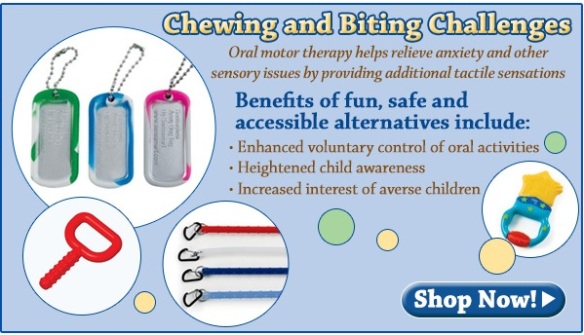Sensory integration can loosely be defined as our ability to register and react to input from our environment across all sensory domains. However, the three particular senses that most affect our sensory integration are the touch (tactile), pressure or body awareness (proprioceptive), and movement (vestibular) senses. Oral motor input, such as biting, sucking, blowing or chewing, affects two of these three senses and is often used (mostly unknowingly) by people of all ages for altering our state of alertness.
With respect to sensory input, depending on the item being used, biting and chewing can meet the sensory needs of two of the three sensory categories (tactile and proprioceptive) and can therefore be a very powerful therapeutic tool. In addition, biting and chewing can be both alerting and calming and are therefore a useful modality for children (or adults) who are both hyper- and hyposensitive to sensory input.
Different textures, flavors and temperatures can be used to enhance the experience. For example, crunchy items tend to increase alertness, while softer, smoother textures show a tendency to increase the calming effect. Flavors such as sour, spicy and bitter will also enhance alertness, whereas sweeter flavors, or flavors such as mint, tend to produce a calming effect. Similarly, warmer temperature will tend to have a calming effect, while colder temperatures tend to be alerting.
Take a look at some of these Oral Motor Therapy products:
Oral Motor Starter Kit (APOM8)
Sensachew DogTag Chewable Pendants (AP5504, AP5502, AP5503)
3″ Buddy Pendand with Necklace (AP5506)
Super Chewnoodles™ (AP11004)
Red Knobby Super Chew (AP92166)
Vibrating Teether (AP246)
*This post was written by Scott Russo and was brought to you by Achievement Products®.

